O C Diver
Guru
- Joined
- Dec 16, 2010
- Messages
- 12,929
- Location
- USA
- Vessel Name
- Slow Hand
- Vessel Make
- Cherubini Independence 45
From Wednesday 06.21.23
Speaking of the Coastguard, things aren't going so well right now. John Deere decided to take some time off.
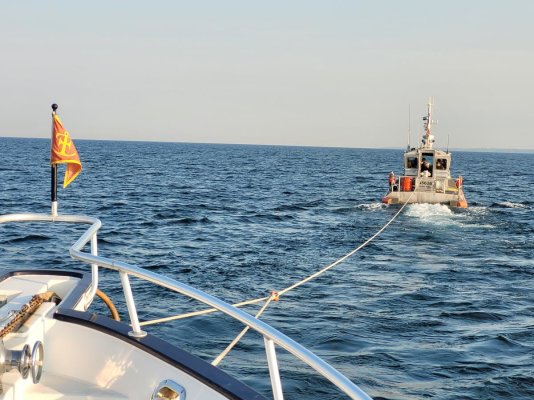
For those who aren't familiar with my projects, I swapped the engine in my boat for a John Deere 4045TFM75. It's a tier 2 diesel that is mechanically injected but electronically controlled. This means the fuel injection pump is electronically controlled by an ECM (Electronic Control Module [computer]). Basically, when you turn the key on, the ECM checks the solenoid control circuit, then the solenoid is activated and moves the throttle position to idle speed. Once you start the engine, increasing the throttle, increases voltage from the ECM to the solenoid, which changes the injection pump setting.
On Wednesday afternoon the engine shutdown. The error message on the display read:
HIGH PRESSURE FUEL PUMP CONTROL VALVE CIRCUIT HAS HIGH RESISTANCE.
The ECM frequently checks the control valve circuit for high resistance, and sensing it, turns the solenoid off. Unfortunately, there is no bypass or get home at high idle mode.
This happened to me in 2017. The resistance limit is about 7 ohms. When it happened, I called the dealer from 5 miles off the shore of Lake Superior. He walked me through the fix. The connectors for the wiring harness are environmentally sealed and self wiping. Basically, removing the connector and replacing it a couple of times wipes the contact surfaces. Removing and replacing the connectors on the ECM and the solenoid resolved the problem. It happened a few days later. This time I cleaned all the surfaces with contact cleaner, enhancer and corrosion inhibiter. Problem solved till last Wednesday.
On Wednesday I repeated my cleaning process. No joy. The dealer I bought the engine from has retired. The boatyard I normally use, now has the franchise. Bobby (one of the owners) was a JD mechanic for several years with an agriculture franchise. He sends me the schematics and diagnostic pages via email (Starlink high speed internet is a beautiful thing!). I disassemble the circuit and check resistance for each component and wire. The wiring harness is only allowed 0.5 ohms of resistance on each lead. The multi meter has more resistance in its wires and probes. Add to that, resistance changes in a hot engine room. So its a game of measuring resistance and subtracting the multi meter's resistance, that keeps changing. Clean everything and put it back together again. It starts; runs 30 seconds; then it dies. Time to get a tow to a harbor of refuge.
Apparently having unlimited BoatUS towing insurance means very little. The BoatUS tow guy didn't want to come 35 miles, tow me, and make a very nice paycheck. Will have to rethink the value of that insurance. USCG came; did a very professional job; had me to the dock by 10:30pm at Port Sanilac. In the rack by 11pm.
Up at 4am to try to solve the problem. Take it all apart again including the cap that converts the coil studs to the Deere connector. Clean everything again and measure all the resistances, again. Including the cap that converts the coil studs to Deere connector, there are 4 connections on each wire. I get a little stuff, but mostly corrosion inhibiter, for all my cleaning.
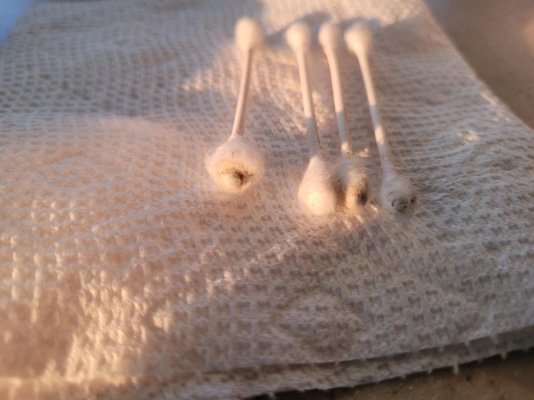
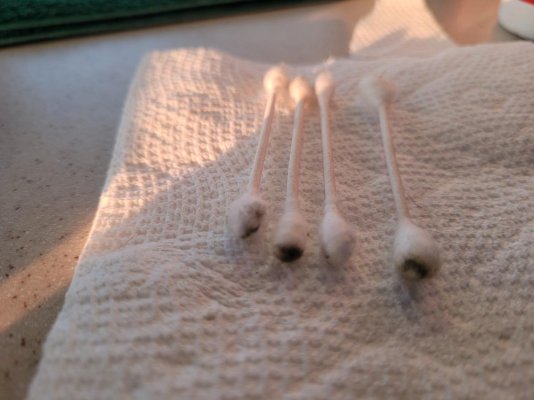
Put it all back together again and it fires right up. I've been here before. I wait 20 minutes without a hiccup before casting off the lines and head out. 30 minutes and about 2 miles North, it quits again.
Drop the hook and take it apart again to see what I might have missed. This time I zip tie the ECM to the wiring harness as oppose to bolting it to the mounting plate. Engine fires right up and hasn't quit since.
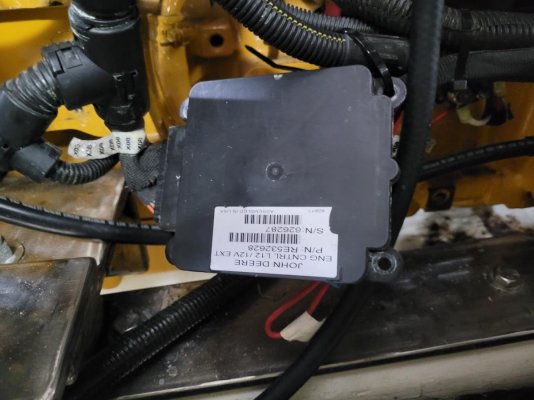
Go back to the marina and wait to call Bobby. We talk about the problem. I think the ECM has gotten heat sensitive. He thinks it's probably resistance in the loop or a bad ground. Further, he says he's never seen an ECM fail and then come back to life, repeatedly.
I head out the next morning and the engine runs flawlessly. While cruising, I decided to use the infrared temperature gun on ECM.
This is the temperature of the ECM in a 104 degree engine room.
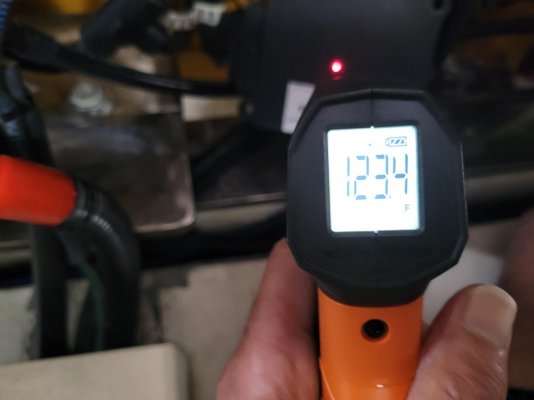
This is the mounting plate for the ECM which is bolted to the crankcase.
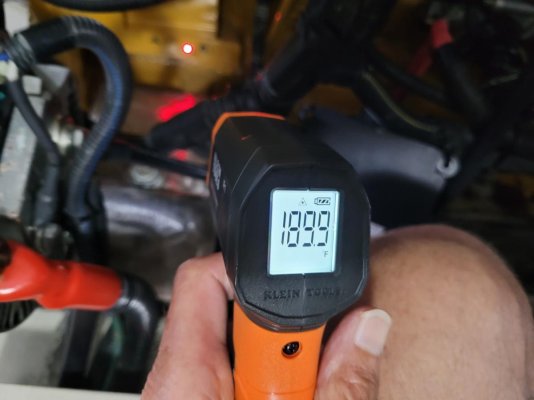
This is the ECM remounted to the plate with 3/4" plastic standoffs.
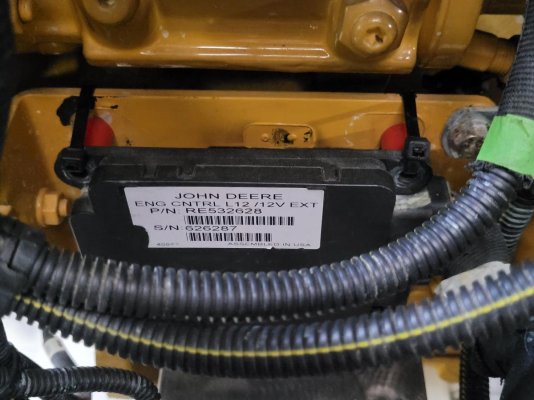
Found out Tuesday that replacing the ECM ($1,800) will also require a technician with the magic software, to download the ECM files while attached to the engine, switch ECMs, and then upload the computer files. Without the magic software, you can't just have a second ECM on the boat as a backup.
Also learned that heat increases resistance in wiring and connections. Have traveled over 350 miles since the last hiccup and am trying to figure out a plan going forward.
Open to suggestions.
Ted
Speaking of the Coastguard, things aren't going so well right now. John Deere decided to take some time off.

For those who aren't familiar with my projects, I swapped the engine in my boat for a John Deere 4045TFM75. It's a tier 2 diesel that is mechanically injected but electronically controlled. This means the fuel injection pump is electronically controlled by an ECM (Electronic Control Module [computer]). Basically, when you turn the key on, the ECM checks the solenoid control circuit, then the solenoid is activated and moves the throttle position to idle speed. Once you start the engine, increasing the throttle, increases voltage from the ECM to the solenoid, which changes the injection pump setting.
On Wednesday afternoon the engine shutdown. The error message on the display read:
HIGH PRESSURE FUEL PUMP CONTROL VALVE CIRCUIT HAS HIGH RESISTANCE.
The ECM frequently checks the control valve circuit for high resistance, and sensing it, turns the solenoid off. Unfortunately, there is no bypass or get home at high idle mode.
This happened to me in 2017. The resistance limit is about 7 ohms. When it happened, I called the dealer from 5 miles off the shore of Lake Superior. He walked me through the fix. The connectors for the wiring harness are environmentally sealed and self wiping. Basically, removing the connector and replacing it a couple of times wipes the contact surfaces. Removing and replacing the connectors on the ECM and the solenoid resolved the problem. It happened a few days later. This time I cleaned all the surfaces with contact cleaner, enhancer and corrosion inhibiter. Problem solved till last Wednesday.
On Wednesday I repeated my cleaning process. No joy. The dealer I bought the engine from has retired. The boatyard I normally use, now has the franchise. Bobby (one of the owners) was a JD mechanic for several years with an agriculture franchise. He sends me the schematics and diagnostic pages via email (Starlink high speed internet is a beautiful thing!). I disassemble the circuit and check resistance for each component and wire. The wiring harness is only allowed 0.5 ohms of resistance on each lead. The multi meter has more resistance in its wires and probes. Add to that, resistance changes in a hot engine room. So its a game of measuring resistance and subtracting the multi meter's resistance, that keeps changing. Clean everything and put it back together again. It starts; runs 30 seconds; then it dies. Time to get a tow to a harbor of refuge.
Apparently having unlimited BoatUS towing insurance means very little. The BoatUS tow guy didn't want to come 35 miles, tow me, and make a very nice paycheck. Will have to rethink the value of that insurance. USCG came; did a very professional job; had me to the dock by 10:30pm at Port Sanilac. In the rack by 11pm.
Up at 4am to try to solve the problem. Take it all apart again including the cap that converts the coil studs to the Deere connector. Clean everything again and measure all the resistances, again. Including the cap that converts the coil studs to Deere connector, there are 4 connections on each wire. I get a little stuff, but mostly corrosion inhibiter, for all my cleaning.


Put it all back together again and it fires right up. I've been here before. I wait 20 minutes without a hiccup before casting off the lines and head out. 30 minutes and about 2 miles North, it quits again.

Drop the hook and take it apart again to see what I might have missed. This time I zip tie the ECM to the wiring harness as oppose to bolting it to the mounting plate. Engine fires right up and hasn't quit since.

Go back to the marina and wait to call Bobby. We talk about the problem. I think the ECM has gotten heat sensitive. He thinks it's probably resistance in the loop or a bad ground. Further, he says he's never seen an ECM fail and then come back to life, repeatedly.
I head out the next morning and the engine runs flawlessly. While cruising, I decided to use the infrared temperature gun on ECM.
This is the temperature of the ECM in a 104 degree engine room.

This is the mounting plate for the ECM which is bolted to the crankcase.

This is the ECM remounted to the plate with 3/4" plastic standoffs.

Found out Tuesday that replacing the ECM ($1,800) will also require a technician with the magic software, to download the ECM files while attached to the engine, switch ECMs, and then upload the computer files. Without the magic software, you can't just have a second ECM on the boat as a backup.
Also learned that heat increases resistance in wiring and connections. Have traveled over 350 miles since the last hiccup and am trying to figure out a plan going forward.
Open to suggestions.

Ted
Last edited:

 In the past, my understanding was the JD would NOT sell a spare ECU to boat owners. There was a settlement/agreement this year to allow non JD dealers to repair JD equipment. It was pushed by farming groups but maybe it has helpped out boat owners.
In the past, my understanding was the JD would NOT sell a spare ECU to boat owners. There was a settlement/agreement this year to allow non JD dealers to repair JD equipment. It was pushed by farming groups but maybe it has helpped out boat owners. 